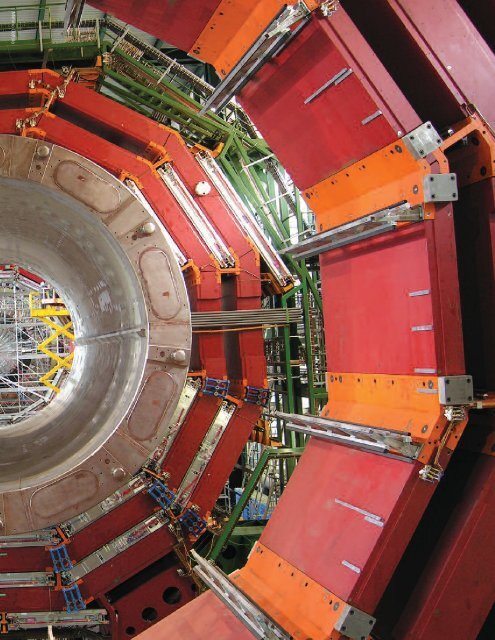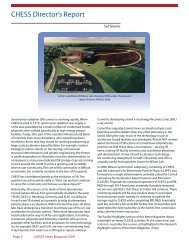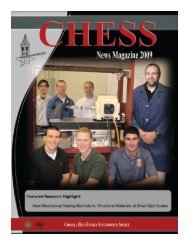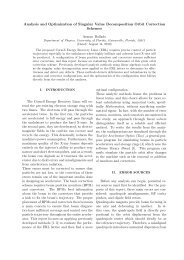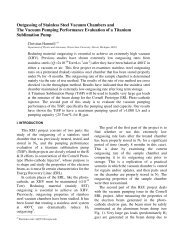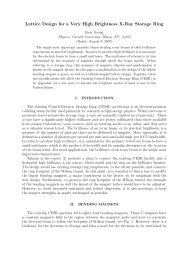M im m o D a tto la - Cornell High Energy Synchrotron Source
M im m o D a tto la - Cornell High Energy Synchrotron Source
M im m o D a tto la - Cornell High Energy Synchrotron Source
Create successful ePaper yourself
Turn your PDF publications into a flip-book with our unique Google optimized e-Paper software.
M<strong>im</strong>mo Da<strong>tto</strong><strong>la</strong>
<strong>Cornell</strong><br />
Theorists<br />
TO TEST THEORIES OF PHYSICS<br />
What Is the Origin of Inertia?<br />
The standard model of strong, electromagnetic, and weak<br />
interactions is the crowning achievement of twentieth-century<br />
physics. The model combines insights from quantum mechanics<br />
and re<strong>la</strong>tivity theory to provide a theoretical description of<br />
physics at the subatomic scale. Over the past three decades,<br />
a series of exper<strong>im</strong>ents has confirmed the predictions of the<br />
theory, often with exquisite precision.<br />
Satisfying as this success is, it by no means represents the<br />
end of the quest to understand nature at its most fundamental,<br />
microscopic level. Rather, it brings into focus a new set of<br />
questions that are not addressed by the standard model. Some<br />
of the questions are these: What is the origin of mass, inertia,<br />
and matter? How does gravity, the only known force left outside<br />
the scope of the standard model, fit in? Why are there so many<br />
(16 at the <strong>la</strong>test count) different kinds of elementary particles<br />
in nature? Recent cosmological observations indicate that only<br />
about five percent of the energy in the universe is in the form<br />
of known particles included in the standard model; of what is<br />
the remaining 95 percent made? Members of the LEPP theory<br />
group are actively engaged in the search for answers.<br />
The Origin of Mass<br />
For years, physicists specu<strong>la</strong>ted that the origin of mass is the<br />
so-called Higgs boson, a particle that so far eludes exper<strong>im</strong>ental<br />
discovery. This nondiscovery motivated some theorists to look<br />
for alternative exp<strong>la</strong>nations: for example, <strong>Cornell</strong>’s Csaba Csaki,<br />
Physics, and his colleagues have recently suggested that there<br />
is no Higgs boson, and the origin of mass is instead re<strong>la</strong>ted to<br />
the existence of a fifth d<strong>im</strong>ension of space curled up to a tiny<br />
size. Even if the Higgs exists, it is very likely that the actual<br />
mechanism of mass generation is more complicated, involving<br />
other new particles and interactions. Theorists have proposed<br />
numerous candidate models. In the near future, the exper<strong>im</strong>ents<br />
at the frontier of next-generation accelerator facilities, the<br />
LHC and the ILC, will provide a definitive test of these ideas.<br />
Considerations of theoretical consistency guarantee that the<br />
new physics involved in the mechanism of mass generation—<br />
whatever it is—will be discovered in the new round of<br />
exper<strong>im</strong>ents. The new exper<strong>im</strong>ental data should enable the<br />
construction of a definitive theory of the origin of mass, and<br />
<strong>Cornell</strong> theorists look forward to participating in the exciting<br />
quest for such a theory.<br />
31
Frank DiMeo<br />
Max<strong>im</strong> Perelstein<br />
MY COLLABORATORS AND I HAVE<br />
RECENTLY USED THE COSMOLOGICAL<br />
DATA ON DARK MATTER ABUNDANCE TO<br />
PREDICT THE RATE AT WHICH THESE<br />
PARTICLES SHOULD BE PRODUCED IN<br />
ACCELERATORS.<br />
32
MASS, ENERGY,<br />
AND LENGTH<br />
LEPP<br />
Dark Matter<br />
Understanding the origin of mass may also shed light on one of<br />
the biggest puzzles in cosmology, the mystery of dark matter.<br />
Judging by its effects on the motion of visible ga<strong>la</strong>xies, dark<br />
matter is ubiquitous in the universe. It seems to be much more<br />
common than the ordinary matter of which stars, p<strong>la</strong>nets, and<br />
humans are made. It must consist of particles that have not yet<br />
been observed in the <strong>la</strong>boratory, probably due to the extreme<br />
weakness of their interactions with ordinary matter. Such particles<br />
are predicted by many models of the origin of mass, and<br />
may be discovered by the exper<strong>im</strong>ents at the LHC and the ILC.<br />
My col<strong>la</strong>borators and I have recently used the cosmological data<br />
on dark matter abundance to predict the rate at which these<br />
particles should be produced in accelerators. Producing and<br />
studying the dark matter particles on Earth will allow my<br />
group to understand their properties in detail.<br />
One potential signature,<br />
identified by Henry Tye,<br />
Physics, and his coworkers,<br />
is that some of the strings<br />
may have been stretched<br />
out by the expansion of<br />
the universe to become extremely <strong>la</strong>rge,<br />
spanning ga<strong>la</strong>ctic and extraga<strong>la</strong>ctic scales.<br />
The leading candidate for a unified theory of gravity and other<br />
forces is string theory, which postu<strong>la</strong>tes that all elementary<br />
particles, rather than being point-like objects with no size, are<br />
extended in one d<strong>im</strong>ension like tiny fragments of a string. This<br />
hypothesis has yielded the first self-consistent quantum theory of<br />
gravity, providing interesting insights into the microscopic nature<br />
of b<strong>la</strong>ck holes, for example. Obtaining exper<strong>im</strong>ental evidence for<br />
string theory is a difficult task, since the typical size of the string<br />
is only a tiny fraction of the proton’s diameter. Studying physics<br />
at such small scales is beyond the reach of even the most powerful<br />
terrestrial accelerators. Nonetheless, if true, string theory<br />
must have p<strong>la</strong>yed a role in the initial moments of the universe’s<br />
existence—in the first nanoseconds after the Big Bang. The<br />
strings then may have left an <strong>im</strong>print on the universe that could<br />
be observed today. One potential signature, identified by Henry<br />
Tye, Physics, and his coworkers, is that some of the strings may<br />
have been stretched out by the expansion of the universe to<br />
become extremely <strong>la</strong>rge, spanning ga<strong>la</strong>ctic and extraga<strong>la</strong>ctic<br />
scales. While not luminous, such cosmic strings could still be<br />
detected, since they would affect the light emitted by the surrounding<br />
stars and emit gravitational waves. Tye and his<br />
students are working with colleagues in <strong>Cornell</strong>’s astronomy<br />
department to identify the most promising signatures.<br />
Max<strong>im</strong> Perelstein<br />
Physics<br />
Frank DiMeo<br />
Modern physics has<br />
uncovered several amazing<br />
re<strong>la</strong>tions between seemingly<br />
different concepts. Perhaps<br />
the most famous one is the<br />
Einstein’s formu<strong>la</strong>, E=mc 2 ,<br />
which connects mass and<br />
energy: any object, even if<br />
it is not moving, has <strong>la</strong>tent<br />
energy. Under the right circumstances,<br />
some of this<br />
“mass energy” can be<br />
converted into other, more<br />
familiar kinds of energy. For<br />
example, in a nuclear power<br />
p<strong>la</strong>nt, the liberated mass<br />
energy of decaying uranium<br />
nuclei is converted into electricity.<br />
The connection<br />
between energy and mass<br />
is so close that today’s<br />
physicists frequently use the<br />
two words interchangeably.<br />
Another interesting re<strong>la</strong>tion is<br />
between energy and length.<br />
According to quantum<br />
mechanics, high energy<br />
particles can be thought of<br />
as waves, and particles of<br />
For more information:<br />
E-mail: mp325@cornell.edu<br />
higher energies have shorter<br />
wavelengths. Optics teaches<br />
us that the max<strong>im</strong>al size of<br />
the object that a wave can<br />
“see” is roughly equal to its<br />
wavelength: this is why<br />
atoms cannot be made visible<br />
to the eye, even with the<br />
most powerful microscope.<br />
Energetic particles from<br />
accelerators allow physicists<br />
to study the structure of<br />
matter at tiny distances. In<br />
physicists’ <strong>la</strong>nguage, “high<br />
energy” is synonymous with<br />
“short distance.”<br />
For example, in<br />
a nuclear power<br />
p<strong>la</strong>nt, the liberated<br />
mass energy of<br />
decaying uranium<br />
nuclei is converted<br />
into electricity.<br />
i


